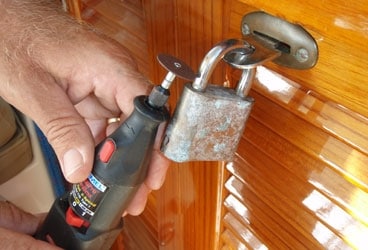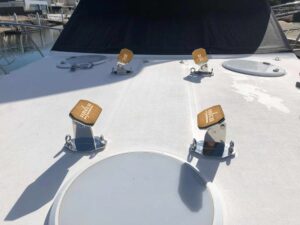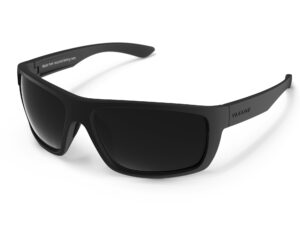
cool tools 368
All true cruisers possess a dark trove of secrets. One hopes that your list of the embarrassing kind is a short one. The most useful hoarded secrets are the ones that defy nautical common sense and aren’t for sale in booths at the boat shows. These are the practical tools and street smarts that only come to a sailor through hard-won experience. I’d like to share a “dirty dozen” roundup of products that you won’t find in the boating books but are usually stocked in neighborhood hardware stores and supermarkets. These items are the ones that have worked well in a variety of strange and challenging situations during my long life around boats.
On my 2006 year-long expedition-style cruise to Patagonia and Cape Horn (see “South to the Horn,” May 2007), I rediscovered the value of these handy items as well as the value of the clothing that serves so well on the ski slopes of my home town of Telluride, Colorado. Wicking long underwear, fleece layers, and breathable waterproof jackets were essential partners in keeping out the brutal weather at the end of the world. One item that proved its worth time and again was a good pair of ski goggles. They allowed me to search for fang-toothed passages in the midst of stinging squalls with horizontal rain. The goggles were comfortable, inexpensive-and indispensable.
Plastic resealable bags are the multitool of cruising. Their utility easily exceeds food-storage applications. “Bag it or lose it” is my position on such essential parts as the springs and pawls of winches, screws, the nuts and bolts of water pumps, impeller O-rings, wafer-thin gaskets, and the like. Every part of every job should immediately be placed into a bag, then each bag labeled with an indelible marker to identify the job-specific contents and their final destination. Bagged spare parts in the depths of lockers are also labeled, visible, and protected. A thin sheet of fabric softener inside a larger-size bag of clear plastic will keep piles of shore clothes dry and sweet smelling during a round trip to Bermuda or a voyage to Tierra Del Fuego and its damp and trying conditions.
Plastic cable ties are a miraculous modern improvement on duct tape, seizing wire, and tarred hemp twine. At your local hardware store, buy them by the gross in assorted lengths and in styles ranging from thin, pastel colored, and flexible to fat, black, and indestructible. I use them for attaching anything to lifelines, shrouds, pulpits, steering pedestals, or my safety harness. Halyard and anchor/chain shackles are locked closed and secured with them, eliminating the chance of receiving a puncture wound caused by the twisted ends of seizing wire. Ties back up all my hose clamps and keep those loose, curling, stainless-steel clamp ends from snagging clothes or skin. Use cable ties in an emergency to hold waterproof tape or other materials around a leaking hose, even one under low pressure. I mark my anchor chain at 20-foot intervals with brightly colored ones; don’t cut off the excess so you can feel them easier in the dark. Once I even used them as effective precautionary handcuffs when rescuing a very frightening (and frightened) three-man crew from an open boat drifting in the trade winds off the coast of Haiti.
Don’t throw away those only slightly punctured bicycle inner tubes. The high-quality, strong, and stretchable rubber in the discarded inner tubes has as many applications in a pinch as a politician has excuses for being caught in a lie with his clothes off. Using an oar or a boat hook as a splint, you can wrap two damaged ends together and mend a broken boom or a snapped whisker pole. I have used sliced-open tubes to wrap a leaking connection to the exhaust hose of my Aqualift muffler, completely stopping the escape of noxious fumes belowdecks. This application also works on any flexible or rigid hose on the boat with the help of a few hose clamps or the cable ties mentioned above. You can also use tubes stretched between two shrouds to launch water balloons across a goodly distance to surprise friends lounging in another boat’s cockpit on a hot afternoon.
After spending a long afternoon polishing stainless-steel winches, pedestals, dorade canopies, stems, anchor chocks, and windlasses, it’s always disheartening to wake up the next morning and see the gleam already beginning to fade, especially since the ultra-space-age miracle stainless-steel polish costs as much as a fifth of 15-year-old single-malt scotch. A trick to keep the shine going without resorting to the high-priced spread is a simple can of spray-on furniture wax. Keep a well-used soft cotton rag and a can of wax in a resealable bag in a seat locker; following a passage, just give the stainless steel a quick swipe after hosing it down. You’ll be amazed at the difference.
Almost going the way of the dodo and the amateur ocean racer is an essential tool that has no 21st-century equal: the heavy-duty wire coat hanger. Absolutely nothing works as well for fishing under, hooking and grabbing, pushing and prodding, or recovering odd bits of flotsam and jetsam that find their way into the most unlikely places and cause the cruiser/mechanic no end of frustration. Besides being free, the wire in a clothes hanger is rigid when it needs to be, bends around corners when it must, is amenable to having a hook or loop put in both ends, and when you use it for the inevitable head duty, you can throw the stinky thing away.
There are many reasons to have kids and bring them along on your cruising boat. The top reason on my list is for their disposable diapers. Can anyone tell me why oil filters are mounted horizontally on most modern engines? Warm oil responds to gravity the second you break the seal. Nothing works quite so well for saving your bilge from an Exxon Valdez moment than a plastic-covered, elastic-banded, sticky-tape-tabbed toddler’s diaper. Experiment to find the initial positioning for the tape before you crack the seal of the filter.
A battery-powered Dremel rotary tool is like Harry Potter’s wand: Almost any wishful task can be accomplished with the right magic attachment. There are easily a hundred uses for this marvelous little device. Attachments include bull-nose wood shapers, carbide-tip cutting tools, and abrasive cleaning pads. I use this tool to cut away the goo-stuck ends of old engine or head hoses, put a new slot in the stripped head of a wood screw, taper down the flange of an oversized elbow in a head, or drill pilot holes for screws in just about any substance, including Kevlar.
Dentists aren’t the only cheerleaders for the daily use of dental floss. Nothing compares to it for quick and easy repairs to awnings, sails, favorite work shorts, and chafing gear. The floss slides easily behind a square-headed sailmaker’s needle and fills its own holes with its waxed coating. It’s tough, durable, and never twists itself into a project-delaying maypole in between stitches. I use it to whip the ends of cut lines on sheets and running rigging and to form a loop in the tail end of a halyard so that a messenger can be attached firmly and securely before removing the line from the mast.
Clear heavy-walled plastic hose should be stored aboard any vessel with a system that stores or moves fluid: fresh water, raw water, gray water, fuel, hydraulics, refrigerator compressor oil, the list goes on. I suggest that you carry both a 3-foot section of clear tube in every dimension to match the hoses on your boat along with 3-inch-long sections of copper tubing that match the inside diameters of the hoses. At some point, to diagnose a problem, you’re going to want to watch the fluid going through a hose. Air pockets in raw-water intake lines and bubbles in a pressurized water system indicate blockages or leaks. Use the clear tubing to check the amount of diesel or water left in a tank by removing the inspection plate, pushing the tube to the bottom, then covering the top of he tube with your thumb. When you pull it up, the length of material held captive in the tube equals the depth of the contents of the tank. When filling an empty tank, I stop every 5 gallons, plunge my designated tank tube into the tank, then mark the height of the contents in the tube with a magic marker. Using this method, I always know my exact liquid reserves, give or take a gallon, while avoiding the chance of a misread gauge.
Have I sung of the virtues of clothespins? They can be used in the galley to close bags of chips and cookies, hold on-deck chartbooks open to the proper page, hang towels on lifelines, and clip the back of my baseball cap to a tuft of my remaining hair. One critical application is to take the two pinchers apart and use the perfect wedge at the finger end to stop those rattling locker doors, loose drawers, or companionway washboards that drive you crazy on overnight sails.
After a rum-filled night at Foxy’s, sailors may well mistake every dark hull in the British Virgin Islands as their own before finding their way home. The anemic beam of your flashlight just won’t do the trick. I always put a length or two of sticky reflective tape on both sides of the mast just above the sail cover, and I’m surprised at how far off a small beam of light can set the strips glowing. I also put a small strip on my mainsail head board and a corresponding mark on the mast near the sail track at the exact heights of the tightened luff for each reef point. In the dark of a squally, wind-filled night, this visual clue tells me exactly how tight to make up the halyard.
R.J. Rubadeau has learned these tricks while logging more than 170,000 miles under sail.








